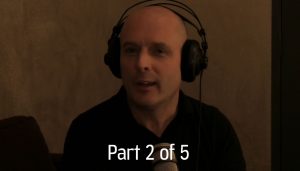FULL EPISODE NOW RELEASED: https://thefatemperor.com/dr-paul-mason-advanced-cholesterol-and-much-much-more-full-podcast-ep26/
Part 3 of 5 – Excellent conversation with super well-researched Australian doctor Paul Mason @DrPaulMason – recorded in Boulder, Colorado. We covered so much!
Full podcast released at the weekend – for those who want to pig out on excellent insights, all in one go 🙂
SUBSCRIBE here for latest releases: https://www.youtube.com/channel/UCPn4FsiQP15nudug9FDhluA
Here is the summary of PART 3 content – scroll down for the Transcript:
INDEX/CONTENT PART 3 of 5:
00:00:00 Coronary Artery Calcification (CAC) versus Intimal Media Thickness (CIMT)
00:07:08 HbA1c and Fructosamine as risk factors
00:10:26 Continuous Glucose Monitors (CGM) and blood glucose fluctuations
00:13:05 Insulin measurements, HOMA IR and post-prandial spikes
TRANSCRIPT for PART 3 of 5:
Ivor 00:29:24 Indeed. Well, I mean, some people, they really want to see all the numbers, they’re enthusiasts, and they’re may be particularly paranoid about heart disease or might have something in the family so although near sure they’re healthy, they’re low-carbers, their trig:HDL ratios are gold, you can never say never so they like to dig deeper.
Paul 00:29:42 Yeah, and you’re a metric kind of guy.
Ivor 00:29:45 To a point, but equally I think it can be overdone. In my personal thing and obviously I worked on behalf of Irish Heart Disease Awareness to promote calcifications gone from middle risk middle aged people, but again, that’s not for people who are really low risk in the bloods. And it’s not for people who are really high risk in the bloods because to be honest those guys, you have to assume they have a problem coming. But for the big middle-risk group, where the bloods are ambiguous and it’s not certain, that group you’ll find the huge disease people, or the zero-disease people.
Paul 00:30:16 Yeah.
Ivor 00:30:16 So that’s what I would say is just get a scan. It’s $100 and find everything…
Paul 00:30:21 Yeah, I actually do use the CAC, the coronary…
Ivor 00:30:24 Oh? In Australia it’s not that common.
Paul 00:30:26 Oh, I use it a lot.
Ivor 00:31:04 Excellent!
Paul 00:31:05 But it’s interesting because if you actually have a look at the way it’s calculated there’s a much more accurate way of getting a calcium score, but the algorithm has actually been patented. So it’s actually if you have a look at the literature, if you’ve ever wondered why, if people have a scan, maybe in close sequence for whatever reason and the numbers jump around a little bit, there’s a lot of random noise down the low levels of the coronary artery calcium score, and that’s because it takes a pick at calcium and then it multiplies it by a certain area and that could be soft plaque or whatever. And it doesn’t truly – at low levels I think, sensitively reflect calcium change. And I think in terms of risk prediction, I think it’s worthwhile having a coronary artery calcium score because you want to know if you’re super high or quite low. But if somebody is quite low, I will then monitor their progress with CIMT rather than with a coronary calcium score
Ivor 00:32:49 But your other point though at the calcification, true, it’s really, “Are you a zero or very low.” “Are you open to hundreds, depending on your age?” “Are you like substantial?” “Are you really high?” They are the guys who want to catch. So in fairness, the CIMT to monitor your month to month progress, calcium more every couple of years for a highly diseased person or every 6, 7, 8 years for someone who’s low. So it’s a much longer term.
Paul 00:33:19 Well the point is you don’t have the noise in the CIMT that you do in the Coronary Artery Calcium score and that’s just because of how it’s calculated.
00:33:29 I’m a little bit disappointed that the better algorithms are actually patented. What can you say?
Ivor 00:33:36 I know, but this often occurs in medicine and you know, business – how to make its money I guess. People should be getting the volume and density as well from the calcium scan. Often they just get the Agatston, the rolled up score…
Paul 00:33:50 And that’s the standard report that we have. We just get the Agatston score really and very rarely where we actually get a graphic.
Ivor 00:33:58 Yeah. I believe nearly any scenario, you can actually ask for the volume and density and generally get it.
The CIMT, there are papers out there, very recent ones that the predictive power of CIMT for future events appears to be very weak. Generally.
Paul 00:34:20 Yeah, and that’s why I do it to monitor progress and not…
Ivor: 00:34:24 Relative.
Paul 00:34:25 Yeah, so compared to where you were before, rather than as an initial risk predictor. I think the Coronary Artery Calcium is the best for risk prediction if you’re looking at an investigation tool like that.
Ivor 00:34:37 Yeah. But the CIMT is a really dynamic kind of, “which way are you heading in a dynamic way?”
Paul 00:34:43 Well, that you should only use certain sonographers. Now it’s actually quite easy. I’ve got an in-room ultrasound and that you can see how it’s easy to make mistakes. So what you want to do, you want to find a landmark like the carotid artery bifurcation and then you go up say three centimeters, an absolute fixed point and you have to zoom, in you have to measure it, you have to be meticulous that you’re in the exact same location and you come in on the same angle. And you have to use the calipers on the screen to market precisely. I mean, I actually… look, so I’ve got in-room ultrasound and I occasionally do it in rooms if I’m not running late. The sonographers I use for it, guys who I trust.
Ivor 00:35:26 Yeah. You have a very special scenario where you’re taking your error and tightening it really tight. On average CIMT people wander into a hospital, get a CIMT, I mean, the operator is clicking where he sees the borders, it’s gone up…
Paul 00:35:40 If you have the same person do it every time, even if there is an error, it systematizes the error. So it makes it reproducible, if not entirely accurate.
Ivor 00:35:50 Yes, exactly. So you, to be quite honest, Paul, you’re a very special advanced application of CIMT from what you described there compared to the generic. If someone walks in the door and gets a CIMT, you know, in “ACME CIMT Company” – God knows what you’ll get….
00:36:08 So we were talking about… oh LDL-Ps. So the LDL-P then, you would have this massive range of markers you’re measuring, the size, the density, the sub fractions, you’re looking at the whole picture as we described earlier. So to our hypothetical person with a 2200 LDL-P who’s healthy, versus the 2200 person who’s seriously unhealthy, you’re going to be able to tell one from the other with all the other measurements you’re looking at.
Paul 00:36:37 Well theoretically, yeah. I mean, yeah, you just plug that in. So let’s take HbA1c as an example measure where you really need to interpret it in context. So a HbA1c is where you have hemoglobin that has sugar attached to it. And we know that that’s, you know compared to cholesterol, it’s probably a better marker of cardiovascular disease because it reflects glycation. But every so often, you’ll see one that will be really high or really low. And it’ll be in congruent with the rest of the risk factors. And in that situation, what often happens is I go looking and I’ll come up with a reason why the HbA1c will be wrong.
00:37:18 So for instance, if you have really rapid cell turnover, if you have a condition, a lot of oxidation in your body causing hemolysis, (destroying of the red blood cells) then you’ve got a fresh population of red blood cells that haven’t had time for sugar to attach so your HbA1c will be lower. Or if you have iron deficiency, or what we call hematinic deficiency where the turnover of red blood cells is slower, well, this is something that we often see in thalassemia condition. So, people from Middle East or Mediterranean region ancestry. Their cells turnover is slower so the HbA1c will be artificially high. And you only know that by you have a look at these other markets in their blood, you say, “Oh ferritins, good. ILT is nice and low.” You know, “Your uric acid is doing this” and you have to look at the whole profile of their biochemistry and then you say, “No, I disagree with that HbA1c.” But I mean, because it is such a powerful marker, we sometimes have to resist the tendency or the urge to put all our balls in one basket.
Ivor 00:38:24 Yeah, I think A1c is great, but as Dr. Kraft said, it failed its component in the sense that it can be misleading in certain times compared to a postprandial insulin result.
Paul 00:38:35 And most people don’t understand. And I mean, I try and control for it, I do a surrogate marker, it’s just fructosamine, which is looking for glycation of protein and the most dominant protein in the serum is album and obviously, that’s got a half life. I think about 21 days. So you compare that to the red blood cells, so that will give you more immediate red glucose levels over the shorter period. But the trouble is the reference ranges. We use in Australia from my lab just absolutely horrible. So I’ve actually got to sit down, I’ve probably got 1000 of them now or something like that. And I really need to sit down and try and work out my own reference ranges because I can’t trust what’s in the literature.
Ivor 00:39:14 Right. You need to know what’s good, bad and indifferent. But at least you’re triangulating the A1c the fructose and getting to a better judgment. That’s what it’s all about, always using…
Paul 00:39:25 … multiple data points.
Ivor 00:39:26 … triangulate. Yeah, that’s the way to go. Of course, the continuous glucose monitors and postprandial measurements of your blood glucose is another good way to guess it whether you’ve got the highest spikes…
Paul 00:39:41 Game changer. That’s been an absolute game changer. It’s absolutely fascinating. I mean, we could talk for hours just about that. But for people understanding the personal effect on their metabolism, in terms of blood sugar levels of the food they’re ingesting, I mean, a lot of people come in and say, “How many carbs? Can I have 20 grams or 30 grams?” But I tell you what will find out is the blood glucose monitor.
00:40:08 And it will also show us a couple of other interesting points. So I mentioned before that glycation leads to oxidative stress. It can lead to a generation of reactive oxygen species. So we know that fluctuations in your blood sugar level are far more deleterious than a stable blood sugar level. And that’s even true. If you have a flat blood sugar level that’s higher, that’s potentially less harmful than somebody who’s got an average blood sugar of lower but it’s spiking all over the place. And that’s where a CGM will give you information that an HbA1c will not.
Ivor 00:40:46 Yes. Even though the two are loosely related by equations, that one is much more dynamic and showing you what’s happening.
Paul 00:40:53 So I want stability and sometimes occasionally what we see, and I don’t fully know the reason that I suspect it’s in athletes because of their need for sugar for anaerobic exercise, especially the anaerobic athletes, when they go on a healthy diet, their sugars will flatline but it will just tend to kick up a notch. And I’m not concerned about that.
Ivor 00:41:19 Exactly. And there’s many people are going keto and low carb. Their A1cs are okay but are often getting fasting blood sugars fairly high…
Paul 00:41:28 Well, fasting is the least useful I think in glucose measures.
Ivor 00:41:32 True, but there’s a lot of excitement and force about running a blood sugar that’s a little higher than the idea low one. But that phenomenon occurs a lot with people who are eating really healthy, low carb diets. They don’t have the glucose spikes.
Paul 00:41:46 You want them to be flatlined. If they might start out at a five or something, sure, but if they don’t go beyond 5.5, and I have a male, couldn’t really care.
Ivor 00:41:57 That’s it or even if they’re averaging at 5.4, but It only goes up to 5.8 after a meal. It’s the postprandial spikes that are the main problems.
Paul 00:42:05 Yeah.
Ivor 00:42:05 And also the beauty of the HOMA Index, if your blood glucose is a little higher but stable, as you say, you really got to look at your insulin. If your blood glucose is a little high but stable and you’re running really high insulin, you’ve got a problem and the higher glucose maybe something to worry about. But if you’re running a really low insulin and you’re this type of person, a healthy person with a higher but flat blood w glucose, it’s okay.
Paul 00:42:31 Well, I have to be honest, several years ago, I was using the HOMA, it was actually the HOMA2-IR.
Ivor 00:42:38 It’s noisy.
Paul 00:42:39 But I’ve actually found it not that useful, I think. So I do a modified craft I’d say on on most of my patients. I’ve got about 500 of them now. It’s relevant for us because craft was described using 100 gram bolus of glucose, and in Australia, we just do 75 grams, so it’s actually being quite interesting to come up with our own normative data on our patient population.
Ivor 00:43:06 And is that working with Catherine Crofts or you’re doing by yourself?
Paul 00:43:10 Well, I will liaise with Catherine. I mean, we’ve had conversation about sharing our data with her and letting her control the numbers. As far as I know, of, in as least in Australia, I don’t know if anybody else has done more than more than we have.
Ivor 00:43:25 500, that’s a lot and you’re doing when you say modified, you’re not doing the full five hour. It’s let’s say two hour?
Paul 00:43:31 Two hours is enough. Two hours is enough. I think you can distinguish between all the different profiles within two hours of data. But what we also do, and it’s really important is you thrown a half an hour measure, because if you’re healthier, your insulin peak will be closer to half an hour, even 20 minutes. And obviously, the insulin peak, the worst metabolic health you have then that gets pushed back.
Ivor 00:43:56 Yes. So that first phase sharp insulin response is actually quite meaningful.
Paul 00:44:01 Oh yeah! If they have a big spike at half an hour and it drops by one hour, hey, that’s nice. You’ve got a good release, a bolus stools of insulin and good capacity and then you’re back to normal. And you very rarely have overshoot.
Ivor 00:44:13 Yeah. And that’s crafted and focus so much on that particular phenomenon. He focus more on the 1,2,3,4 or 5 hours. The way he put up was, if you’re ambiguous at two hour, if you’re between 30 and 40 micro units, then maybe the third and fourth hour can help. But I don’t think he focused so much on the first hour.
Paul 00:44:31 One thing that I really actually do like is I get patients to wear a continuous glucose monitor. I think after two hours, I don’t really care about insulin so much but the glucose, because you will often see a delayed reactive hypoglycemia. And that’s not uncommon at three hours. And we pick that up on the CGM trace.
Ivor 00:44:49 Yeah, that’s nice. Now of course, if you do a full insulin, I’d say you’re going to pick it up too because you’re gonna do three four or five hours glucose and insulin assays. But who wants to do that?
Paul 00:44:56 Nobody wants to do that.
Ivor 00:44:57 Yeah, it’s too much.
Paul 00:44:58 Yeah, when I say, “Ah, you got to take care two hours out of your day,” most people look like I’ve just eaten their lunch or something.
Ivor 00:45:04 Exactly.
Paul 00:45:05 “You just what?”
Ivor: 00:45:07 Yeah. Meridian Valley Labs in the US, they have a blotter where you can do a full five-hour test, but you can just do it in the comfort of your own home with a blotter.
Paul 00:45:15 Okay.
Ivor 00:45:15 You get your insulin glucose on blood drops on a cardboard sheet. That is pretty sexy and I think it’s pretty cheap. But you’re right, no way you’re going to hook up to a machine for a few hours.
Paul 00:45:26 You know, universal health care in Australia, I mean, this is all you know, if it’s medically indicated, which most people come into me with metabolic arrangements it is, that’s covered by Medicare. That’s fantastic.
Ivor 00:45:36 Hey, hold on a minute. We’re sitting in America as we talk. We’re in Boulder, Colorado. You sound like socialist.
Paul 00:45:43 I’m not trying – I am actually.








